八年级英语人教版下册 Unit 1 What's the matter. Section B (1a-1d) 课件(共20张PPT)
文档属性
| 名称 | 八年级英语人教版下册 Unit 1 What's the matter. Section B (1a-1d) 课件(共20张PPT) | 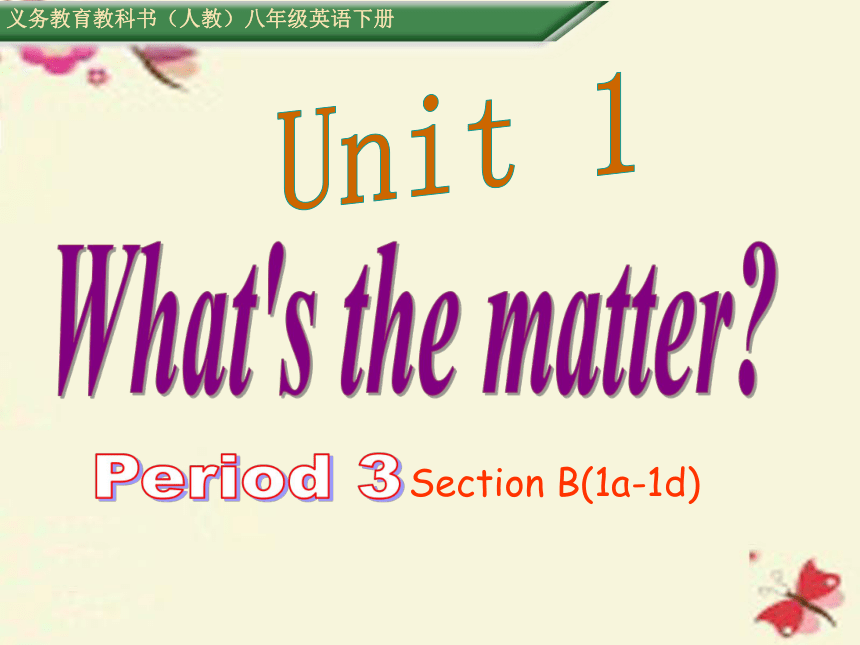 | |
| 格式 | zip | ||
| 文件大小 | 284.8KB | ||
| 资源类型 | 教案 | ||
| 版本资源 | 人教新目标(Go for it)版 | ||
| 科目 | 英语 | ||
| 更新时间 | 2023-02-06 08:09:21 | ||
图片预览

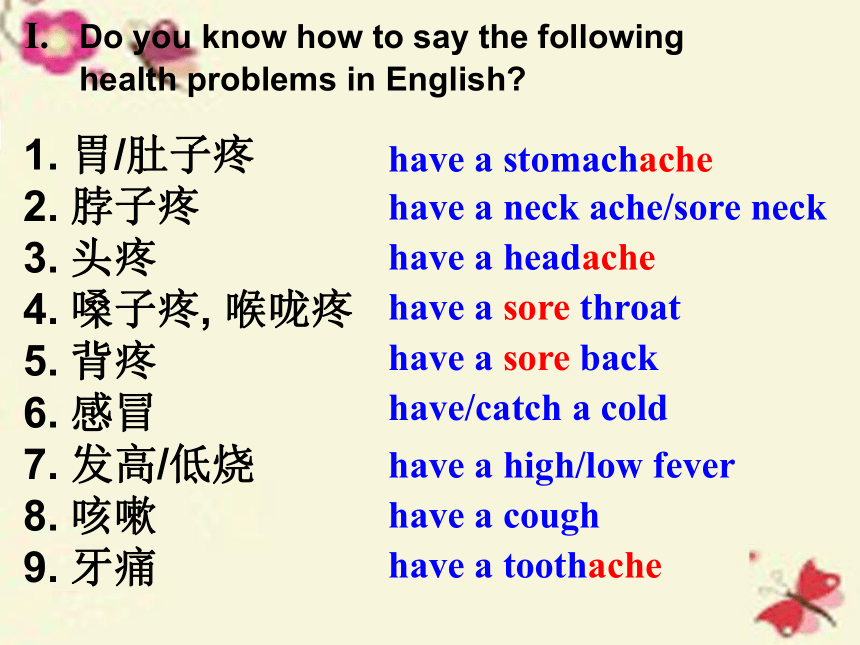
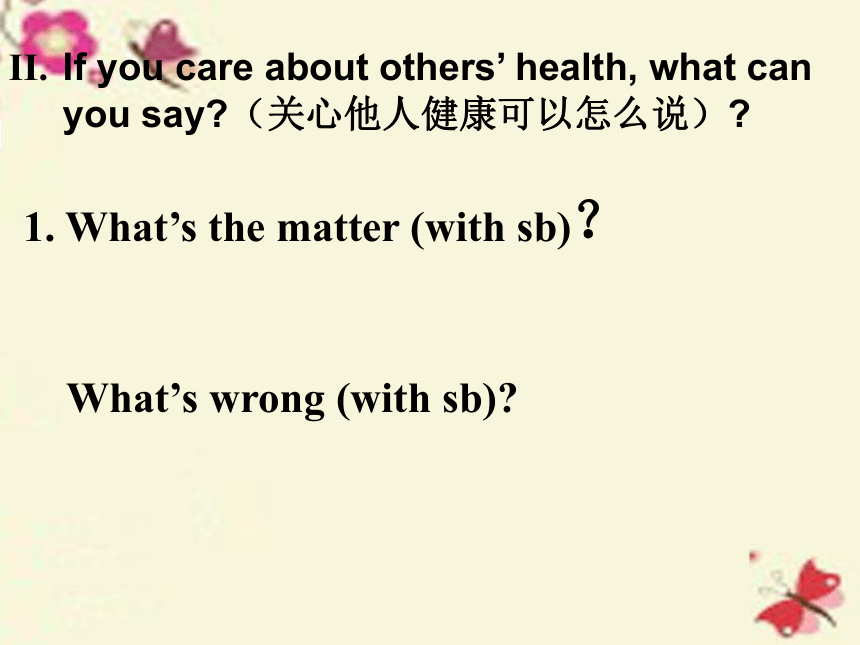
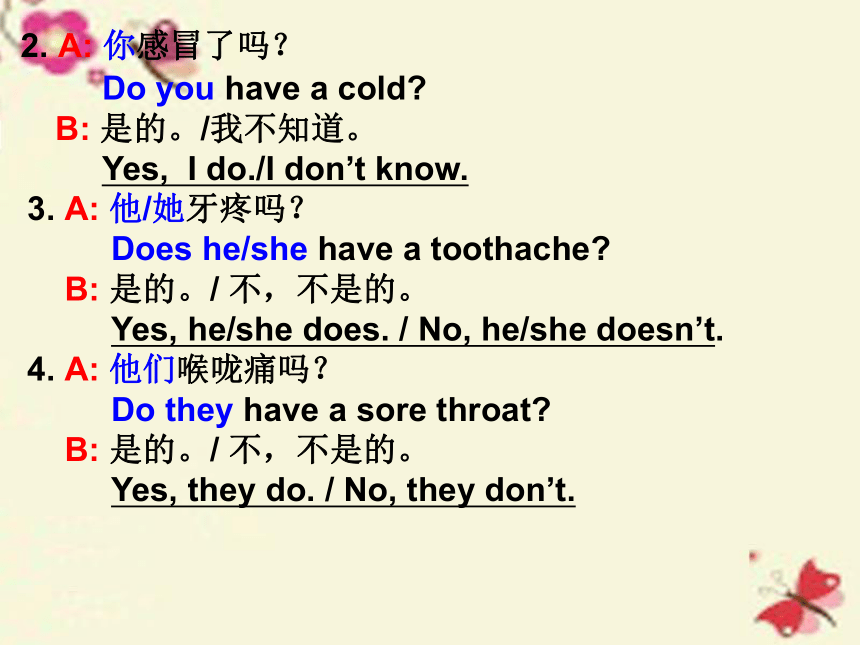
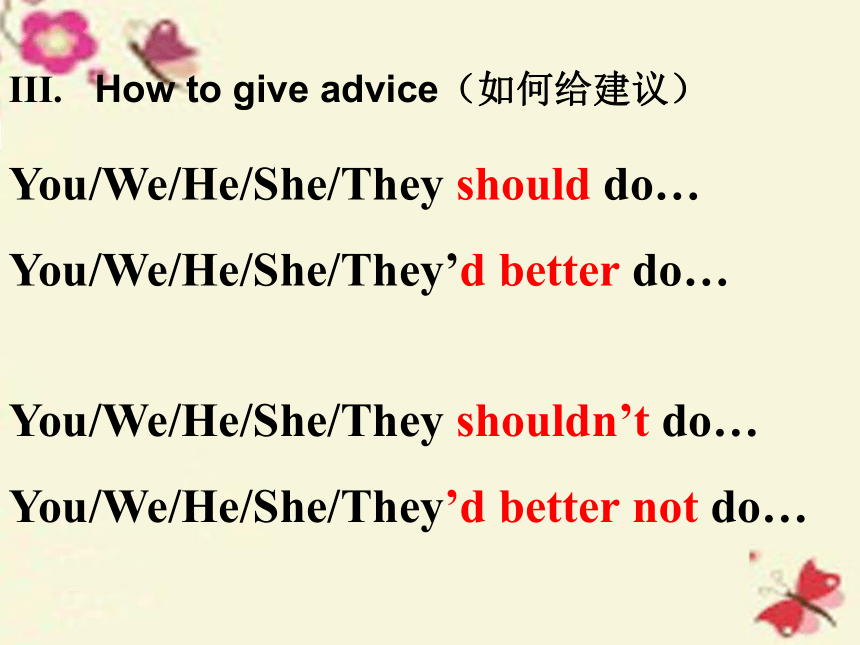
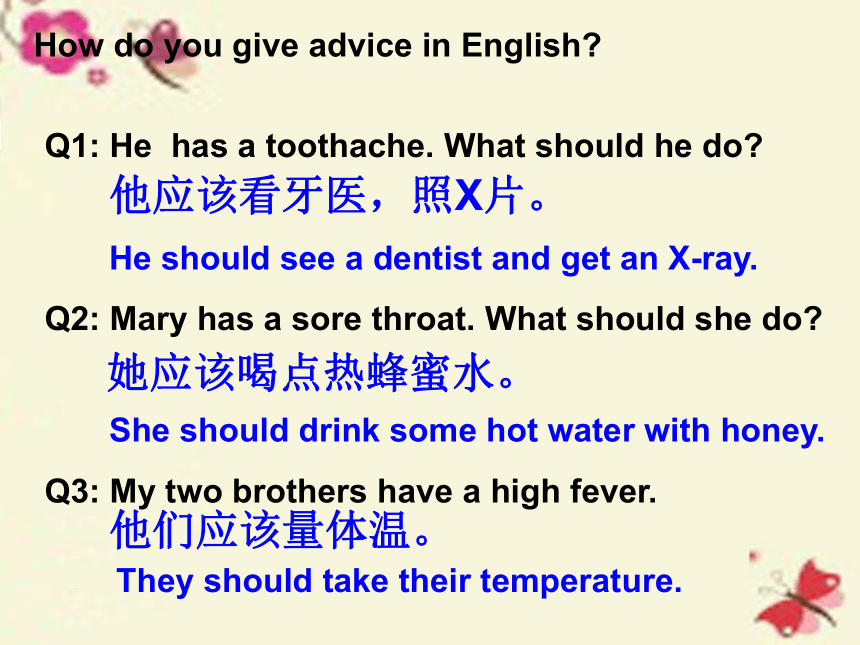
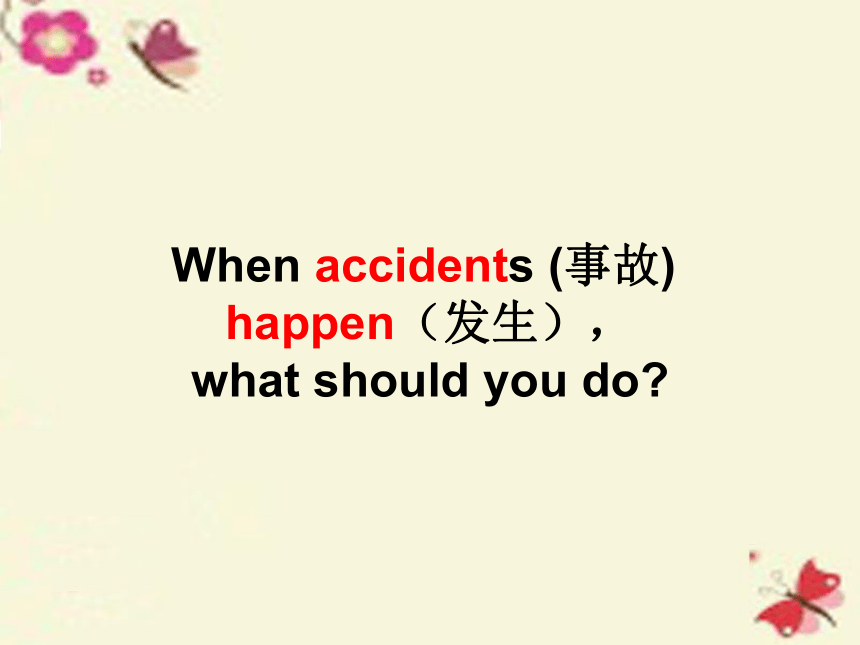
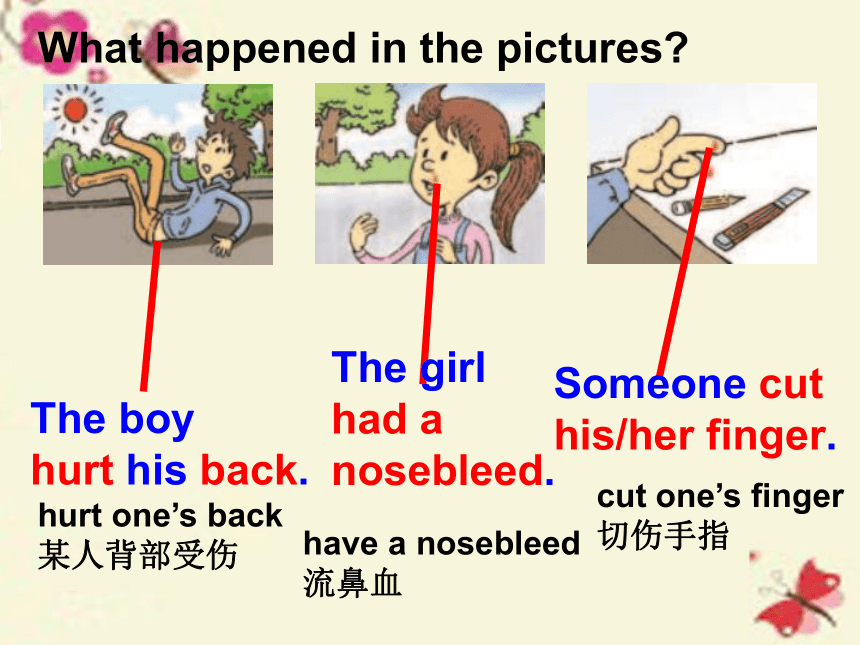
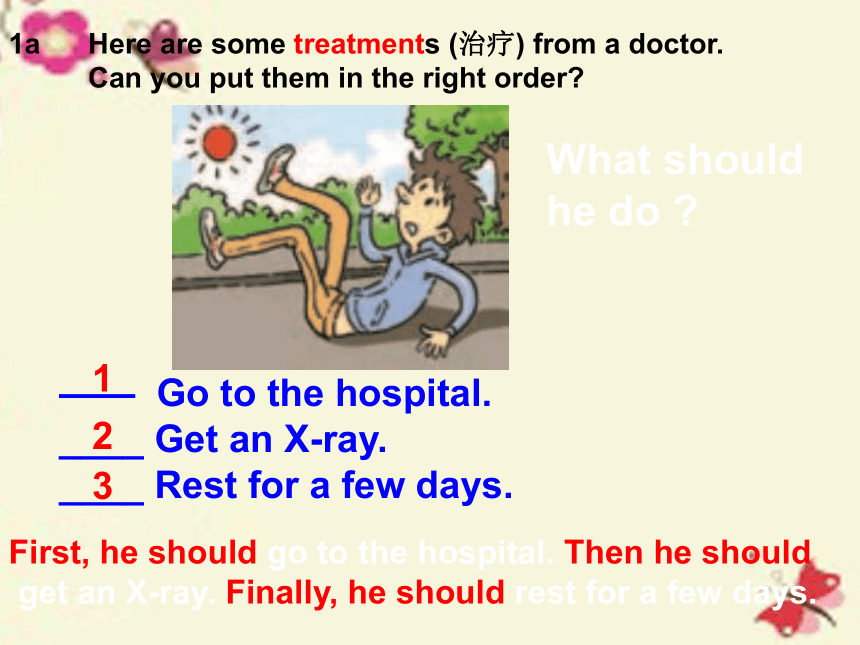
文档简介
(共20张PPT)
What's the matter
义务教育教科书(人教)八年级英语下册
Unit 1
Period 3
Section B(1a-1d)
1. 胃/肚子疼
2. 脖子疼
3. 头疼
4. 嗓子疼, 喉咙疼
5. 背疼
6. 感冒
7. 发高/低烧
8. 咳嗽
9. 牙痛
I. Do you know how to say the following health problems in English
have a stomachache
have a neck ache/sore neck
have a headache
have a sore throat
have a sore back
have/catch a cold
have a high/low fever
have a cough
have a toothache
1. What’s the matter (with sb)?
What’s wrong (with sb)
II. If you care about others’ health, what can you say (关心他人健康可以怎么说)
2. A: 你感冒了吗?
Do you have a cold
B: 是的。/我不知道。
Yes, I do./I don’t know.
3. A: 他/她牙疼吗?
Does he/she have a toothache
B: 是的。/ 不,不是的。
Yes, he/she does. / No, he/she doesn’t.
4. A: 他们喉咙痛吗?
Do they have a sore throat
B: 是的。/ 不,不是的。
Yes, they do. / No, they don’t.
III. How to give advice(如何给建议)
You/We/He/She/They should do…
You/We/He/She/They’d better do…
You/We/He/She/They shouldn’t do…
You/We/He/She/They’d better not do…
Q1: He has a toothache. What should he do
他应该看牙医,照X片。
Q2: Mary has a sore throat. What should she do
她应该喝点热蜂蜜水。
Q3: My two brothers have a high fever.
How do you give advice in English
他们应该量体温。
He should see a dentist and get an X-ray.
She should drink some hot water with honey.
They should take their temperature.
When accidents (事故)
happen(发生),
what should you do
What happened in the pictures
The boy
hurt his back.
The girl
had a
nosebleed.
Someone cut his/her finger.
hurt one’s back
某人背部受伤
have a nosebleed
流鼻血
cut one’s finger
切伤手指
1a Here are some treatments (治疗) from a doctor.
Can you put them in the right order
—— Go to the hospital.
____ Get an X-ray.
____ Rest for a few days.
1
2
3
First, he should go to the hospital. Then he should
get an X-ray. Finally, he should rest for a few days.
What should
he do
___ Clean her face.
___ Put her head back.
___ Put on a clean T-shirt.
___ Put a bandage on it.
___ Run it under water.
___ Put some medicine on it.
3
1
2
2
1
3
What should she do
First, she should… Second, she should… Finally, she should…
1b Listen to the school nurse. Check (√ ) the problems
you hear.
Problems
Someone felt sick. ( )
Someone cut his knee. ( )
Someone had a fever. ( )
Someone had a nosebleed. ( )
Someone hurt his back. ( )
Someone got hit on the head. ( )
√
√
√
1c Listen again. Write the letter of each treatment next to the
problems you checked in the chart above.
Problems Treatments
Someone felt sick. ( )
Someone cut his knee. ( )
Someone had a fever. ( )
Someone had a nosebleed. ( )
Someone hurt his back. ( )
Someone got hit on the head. ( )
a. put a bandage on it b. took his temperature
c. told him to rest d. put some medicine on it
e. took him to the hospital to get an X-ray
f. told her to put her head back
a、d
f
e
Treatments
b、c
1d Role-play a conversation between the nurse and the
teacher. Use the information in 1b and 1c.
A: Who came to your office today
B: First, a boy came in. He hurt himself in P.E. class.
A: What happened
B: …
B: He hurt his back.
A: What should he do
B: First, he should go to the
hospital. Then he should
get an X-ray. Finally, he should
rest for a few days.
Pairwork
Teacher: Who came to your office today
Nurse: First, a girl/ boy…
Teacher: What happened
Nurse: …
…
Make a conversation with your partner.
illness: a disease of the body
or mind, or the condition of being ill
指身体上或精神上的疾病。
accident: sth that happens without
anyone planning or intending it
一般是指造成死亡、伤害、
损坏或者其他损失的意外情况。
区分 illness和accident
What happened
happen
vi.引起,发生。 通常指发生意外和事故。
eg. 意外有时候会发生。
Accidents sometimes happen.
常用的搭配有: happen to sb 降临到(某人)身上
What happened to you
你怎么了?(意为 “什么事情降临到你身上了”)
2. 如何询问发生事情。
What should I/he/she/we/they do
我/他/她/我们/他们应该怎么做?
在给别人建议时,应该说:
Sb. should do sth (should + V原形))
你应该好好休息。
You should have a good rest.
他们应该睡一觉。
They should get some sleep.
他应该去医院看看。
He should go to the hospital.
3.如何询问建议。
4. 碰到意外事故时,应该如何给别人建议。
因为意外事故通常比普通的病痛较难处理,因此
在给对方建议时应该有步骤的说明该做的事情。
e.g. A:发生什么事了?
What happened
B: 我腿受伤了。我该怎么办?
I hurt my leg. What should I do
A: 首先,你应该去医院。 其次,你应该照X片。
First, you should go to the hospital.
Second/Then, you should get an X-ray.
最后,你应该好好休息几天。
Finally, you should rest for a few days.
注:可通过使用first (首先)和 second(其次/第二)等序数词
来表达动作先后顺序。也可以用then (然后)来说明中间的步骤。
最后的动词可以用finally (最后)来表示。
用绷带包扎一下
put a bandage on it
用水冲洗
run it/sth under water
上药
put some medicine on it
把头后仰
put one’s head back
穿一件干净的T恤
put on a clean T-shirt
5. 常见的伤口处理方法
洗脸
clean one’s face
去医院
go to the hospital
照X片
get an X-ray
休息几天
rest for a few days
结束语
Knowledge is a measure, but practise is the key to it.知
识是珍宝,而实践是获取它的钥匙.
What's the matter
义务教育教科书(人教)八年级英语下册
Unit 1
Period 3
Section B(1a-1d)
1. 胃/肚子疼
2. 脖子疼
3. 头疼
4. 嗓子疼, 喉咙疼
5. 背疼
6. 感冒
7. 发高/低烧
8. 咳嗽
9. 牙痛
I. Do you know how to say the following health problems in English
have a stomachache
have a neck ache/sore neck
have a headache
have a sore throat
have a sore back
have/catch a cold
have a high/low fever
have a cough
have a toothache
1. What’s the matter (with sb)?
What’s wrong (with sb)
II. If you care about others’ health, what can you say (关心他人健康可以怎么说)
2. A: 你感冒了吗?
Do you have a cold
B: 是的。/我不知道。
Yes, I do./I don’t know.
3. A: 他/她牙疼吗?
Does he/she have a toothache
B: 是的。/ 不,不是的。
Yes, he/she does. / No, he/she doesn’t.
4. A: 他们喉咙痛吗?
Do they have a sore throat
B: 是的。/ 不,不是的。
Yes, they do. / No, they don’t.
III. How to give advice(如何给建议)
You/We/He/She/They should do…
You/We/He/She/They’d better do…
You/We/He/She/They shouldn’t do…
You/We/He/She/They’d better not do…
Q1: He has a toothache. What should he do
他应该看牙医,照X片。
Q2: Mary has a sore throat. What should she do
她应该喝点热蜂蜜水。
Q3: My two brothers have a high fever.
How do you give advice in English
他们应该量体温。
He should see a dentist and get an X-ray.
She should drink some hot water with honey.
They should take their temperature.
When accidents (事故)
happen(发生),
what should you do
What happened in the pictures
The boy
hurt his back.
The girl
had a
nosebleed.
Someone cut his/her finger.
hurt one’s back
某人背部受伤
have a nosebleed
流鼻血
cut one’s finger
切伤手指
1a Here are some treatments (治疗) from a doctor.
Can you put them in the right order
—— Go to the hospital.
____ Get an X-ray.
____ Rest for a few days.
1
2
3
First, he should go to the hospital. Then he should
get an X-ray. Finally, he should rest for a few days.
What should
he do
___ Clean her face.
___ Put her head back.
___ Put on a clean T-shirt.
___ Put a bandage on it.
___ Run it under water.
___ Put some medicine on it.
3
1
2
2
1
3
What should she do
First, she should… Second, she should… Finally, she should…
1b Listen to the school nurse. Check (√ ) the problems
you hear.
Problems
Someone felt sick. ( )
Someone cut his knee. ( )
Someone had a fever. ( )
Someone had a nosebleed. ( )
Someone hurt his back. ( )
Someone got hit on the head. ( )
√
√
√
1c Listen again. Write the letter of each treatment next to the
problems you checked in the chart above.
Problems Treatments
Someone felt sick. ( )
Someone cut his knee. ( )
Someone had a fever. ( )
Someone had a nosebleed. ( )
Someone hurt his back. ( )
Someone got hit on the head. ( )
a. put a bandage on it b. took his temperature
c. told him to rest d. put some medicine on it
e. took him to the hospital to get an X-ray
f. told her to put her head back
a、d
f
e
Treatments
b、c
1d Role-play a conversation between the nurse and the
teacher. Use the information in 1b and 1c.
A: Who came to your office today
B: First, a boy came in. He hurt himself in P.E. class.
A: What happened
B: …
B: He hurt his back.
A: What should he do
B: First, he should go to the
hospital. Then he should
get an X-ray. Finally, he should
rest for a few days.
Pairwork
Teacher: Who came to your office today
Nurse: First, a girl/ boy…
Teacher: What happened
Nurse: …
…
Make a conversation with your partner.
illness: a disease of the body
or mind, or the condition of being ill
指身体上或精神上的疾病。
accident: sth that happens without
anyone planning or intending it
一般是指造成死亡、伤害、
损坏或者其他损失的意外情况。
区分 illness和accident
What happened
happen
vi.引起,发生。 通常指发生意外和事故。
eg. 意外有时候会发生。
Accidents sometimes happen.
常用的搭配有: happen to sb 降临到(某人)身上
What happened to you
你怎么了?(意为 “什么事情降临到你身上了”)
2. 如何询问发生事情。
What should I/he/she/we/they do
我/他/她/我们/他们应该怎么做?
在给别人建议时,应该说:
Sb. should do sth (should + V原形))
你应该好好休息。
You should have a good rest.
他们应该睡一觉。
They should get some sleep.
他应该去医院看看。
He should go to the hospital.
3.如何询问建议。
4. 碰到意外事故时,应该如何给别人建议。
因为意外事故通常比普通的病痛较难处理,因此
在给对方建议时应该有步骤的说明该做的事情。
e.g. A:发生什么事了?
What happened
B: 我腿受伤了。我该怎么办?
I hurt my leg. What should I do
A: 首先,你应该去医院。 其次,你应该照X片。
First, you should go to the hospital.
Second/Then, you should get an X-ray.
最后,你应该好好休息几天。
Finally, you should rest for a few days.
注:可通过使用first (首先)和 second(其次/第二)等序数词
来表达动作先后顺序。也可以用then (然后)来说明中间的步骤。
最后的动词可以用finally (最后)来表示。
用绷带包扎一下
put a bandage on it
用水冲洗
run it/sth under water
上药
put some medicine on it
把头后仰
put one’s head back
穿一件干净的T恤
put on a clean T-shirt
5. 常见的伤口处理方法
洗脸
clean one’s face
去医院
go to the hospital
照X片
get an X-ray
休息几天
rest for a few days
结束语
Knowledge is a measure, but practise is the key to it.知
识是珍宝,而实践是获取它的钥匙.
同课章节目录
- Unit 1 What's the matter?
- Section A
- Section B
- Unit 2 I'll help to clean up the city parks.
- Section A
- Section B
- Unit 3 Could you please clean your room?
- Section A
- Section B
- Unit 4 Why don't you talk to your parents?
- Section A
- Section B
- Unit 5 What were you doing when the rainstorm came
- Section A
- Section B
- Review of Units 1-5
- Unit 6 An old man tried to move the mountains.
- Section A
- Section B
- Unit 7 What's the highest mountain in the world?
- Section A
- Section B
- Unit 8 Have you read Treasure Island yet?
- Section A
- Section B
- Unit 9 Have you ever been to a museum?
- Section A
- Section B
- Unit 10 I've had this bike for three years.
- Section A
- Section B
